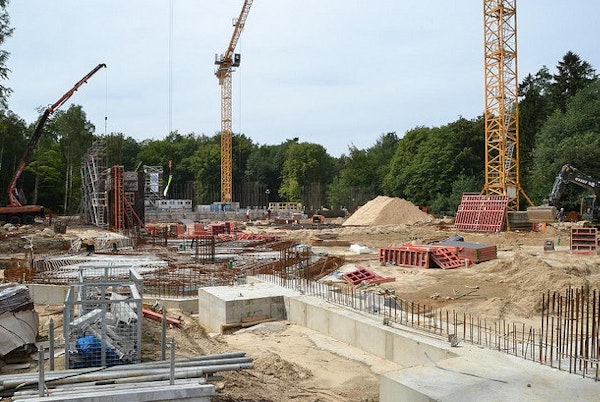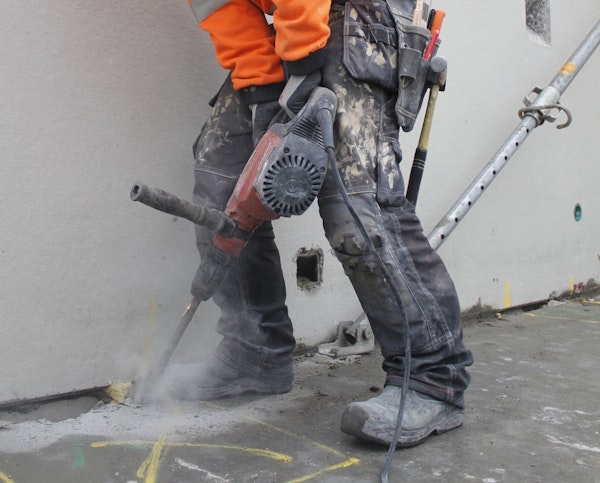Construction sites across the UK present a community of constantly changing, highly hazardous and potentially risk-riddled environments. There are over 2 million employees across these sites in the UK, who are vulnerable to both work-related illness and injury. According to Health and Safety Executive, typical statistics relating to the UK construction industry demonstrate the scale of this considerable problem:
- The construction industry struggles with 2.2 million lost days of work (on average, per year).
- 3% of workers – an estimated 66,000 individuals – sustain work-related injuries per year (average 2013 – 2016).
- There were 43 deaths in the construction industry in 2015/2016. These accident-related fatalities are more than twice the average of other industries.
- 64% of issues arise from musculoskeletal work-related disorders (average 2013 – 2016). At a total of 1.2 million lost working days, these injuries account for over half of the days lost per year.
HSE recommends treating all health risks as safety risks, in order to put a focus on prevention of health-related illness as well as accidents, but in order for employers and construction companies to respond to this recommendation, it’s important to know exactly where the risks lie and how to reduce them effectively:
- Risk: Movement
The backdrop of a construction site is constantly changing across daily tasks as well as phases of work and includes a potentially disastrous combination of moving objects, construction vehicles, lifting equipment, heavy loads and uneven terrain. Additional risks come from moving around construction sites, with the uneven ground surface presenting the risk of tripping, slipping or falling.
-
- Reduction: Traffic delineation, such as using barrier runs to create safe zones can help protect workers and visitors from moving vehicles. Barriers should also be deployed to safely cordon trip hazards, holes and the rising stages of buildings and minimise risk of slips, trips and falls, whilst ground protection and ground guards can reduce uneven terrain and create safe loading and unloading zones for heavy equipment.
- Risk: Harmful materials
From older lead paint to asbestos, historic building materials still present risks to contemporary construction workers. Asbestos was widely used in construction throughout the 20th century and features in many properties being demolished or refurbished in the 21st century. Although largely harmless when undisturbed, asbestos can cause serious effects once its constituent particles are disturbed. Like asbestos particles, construction dust also presents another airborne hazard which could cause serious respiratory and visual problems but these aren’t the only harmful substances construction workers are exposed to, as products such as chemicals, paints, vapours and gases are prevalent across construction sites.
-
- Reduction: Site managers and the companies they represent have a duty of care towards prevention and prompt action in the event of problems from harmful materials. As such, planning engineers and workers should be aware of the likelihood of asbestos and how to identify and safely manage its removal and disposal from construction sites.In all aspects of working with hazardous materials, including dust and toxic substances, eyes and airways should be protected at all times.
- Risk: Working at height and falling items
Construction, demolition and repair can all involve staff working at height. This can include floors, ceilings and roofs under construction or in damaged, vulnerable states, as well as hazards arising from movement and accessibility issues in reaching and working in high-up areas. Falls from height accounted for 20% of injuries in 2015/16 (HSE), with height hazards – that of debris, tools or materials falling from a height – accounted for another 11% of injuries of workers being struck by falling objects.
-
- Reduction: All staff should be trained in the safety processes required for working at height, with stringent procedures in place to help prevent falling objects. Risk-assessment should take place regularly as accessibility and mobility issues become compounded by the progress or stage of work and appropriate equipment should always be used as required, such as properly erected scaffolding or towers, rather than ladders.
- Risk: Electricity
There are over twice as many deaths from electrocution in the construction industry than across all other industries. Construction workers are at risk from electrocution in their use of tools as well as proximity to overhead cables and power lines, which puts construction workers at additional risk.
-
- Reduction: All movement and work around overhead cables needs to be thoroughly risk assessed so that all workers, not just electricians are protected. All workers undertaking electrical works should be fully qualified electricians.
- Risk: Noise
Noise, including the repetitive sounds from high-decibel machinery and tools, presents a multiple risk to construction workers: it has a physical effect on ears, can be a distraction and may also have an impact on communication between workers, causing failure to hear warning signals or alarms. Prolonged exposure to construction tools and noise over a number of years can result in occupational injury such as gradual hearing loss whilst sudden, loud sounds can put workers at risk of deafness or Tinnitus.
-
- Reduction: Adequate risk assessment, training and processes to protect construction workers from site and specific machinery noise is essential. Safeguards, including ear protection must also be in place following full risk assessment.
- Risk: Manual handling
Manual handling is wider than just picking up or moving heavy items. On a construction site particularly, it also Includes the use of mechanical lifting tools. Accidents and occupational injury through poor manual handling accounted for 22% of construction site injuries in 2015/16 (HSE).
-
- Reduction: Adequate training needs to be given to ensure competent, risk-minimal manual handling and safe use of lifting equipment.
- Risk: Hand arm vibration and musculoskeletal conditions
That massive 64% of injuries through musculo-skeletal conditions arises from the prolonged use of ground working equipment and vibrating power tools. These tools can cause damage to hands – affecting joints, nerves and blood vessels with any small fibre nerve damage being largely irreversible. The prolonged use of larger impact tools, such as jackhammers, may also affect shoulders, neck and spinal discs. Crucially for workers, continued work when body is already showing signs of such injuries can result in permanent disability. As well as prolonged use, construction workers are also at particular risk of musculoskeletal conditions when working with poorly maintained tools and when subject to poor working practices.
-
- Reduction: individual risk assessment relating to users and tools specifically should always take place. Safety equipment, including gloves and other protection should be adequate and available and there should also be a full schedule of tool maintenance and effective working practices (including the provision of breaks or task changes) to reduce prolonged periods of working with such machinery.
- Risk of collapse
Although demolition sites naturally include a particular risk of building or ground collapse, any building or ground works in a state of incompleteness presents an increased risk of collapse. Inadequate provision or erection of scaffolding can also exacerbate issues of collapse.
-
- Reduction: the risks of building or trench collapse can be minimised by good preparation and precautionary protection for site staff, to prevent serious injury and fatalities. Risk assessment and precautionary measures need to be in place before work commences. Scaffolding should also undergo additional risk assessment and only be erected by fully qualified workers.
Overall, risks on construction sites arise because of the hazardous nature of the working environment, the physically demanding nature of the work and the fact that some of the most damaging occupational injuries happen over a considerable period of time.
Risk minimisation is the responsibility of construction companies and site managers, who have a duty of care to construction site staff, visitors and public, whilst construction workers also have their own role to play and should report risks such as damaged equipment or problems to their line managers immediately.
At all levels, active risk management through prevention is crucial – from providing construction site safety fencing to provide a secure barriers against trespass as well as to provide site barriers for accident prevention and access limitation, keeping people and vehicles safely apart during the busy construction day and following HSE recommendations across all aspects of those major risk areas. As such, prevention also includes a full (and frequent) schedule of risk-assessment, monitoring and reporting to help reduce the human cost of fatality and injury in construction and to maximise health and safety.


